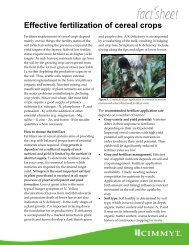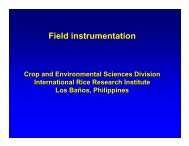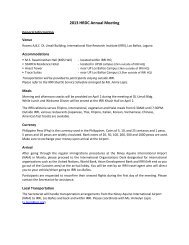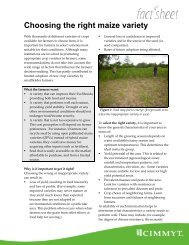Rice Stripe - Rice Knowledge Bank - International Rice Research ...
Rice Stripe - Rice Knowledge Bank - International Rice Research ...
Rice Stripe - Rice Knowledge Bank - International Rice Research ...
You also want an ePaper? Increase the reach of your titles
YUMPU automatically turns print PDFs into web optimized ePapers that Google loves.
<strong>Rice</strong> <strong>Stripe</strong><strong>Rice</strong> <strong>Stripe</strong> – Page 1 of 4Distribution<strong>Rice</strong> stripe virus disease (RSVD) occurs in the temperate regions of East Asia, specifically China,Japan, Korea, and Taiwan, and it has also been reported from far-eastern Russia (Ou 1985).rice fact sheetsEconomic importanceRSVD is one of the most serious diseases of rice in the temperate regions of East Asia. It can causehigh yield losses when severe epidemics occur. It has affected several thousand hectares of ricegrowingareas (Table 1). Severe infection at the seedling to early tillering stage was reported to causeyield losses of 50% to 100% (Lin et al 1990). In eastern China, RSVD caused yield losses of 30% to40% in 2003-04 (Zhang et al 2007).Table 1. Some reported epidemics of RSVD.Year Country Area affected (ha) Reference1960s Japan 500,000 Maeda et al (2006)1960s Eastern and southern China 2,660,000 Wang et al (2008)1963-67 Japan 500,000 to 620,000 (annually) Nemoto et al (1994)1973 Japan 620,000 Ou (1985)1986 Japan 170,000 Nemoto et al (1994)1973 Taiwan 1,045 Lee (1975)Not indicated Yunnan Province, China 67,000 Wang et al (2008)2002 Jiangsu Province, China 780,000 Wei et al (2009)2003 Jiangsu Province, China 957,000 Wei et al (2009)2004 Jiangsu Province, China 1,571,000 Wei et al (2009)2005-06 Zhejiang Province, China 100,000 Wang et al (2008)2007-08 Korea 84% of rice fields Jonson et al (2009)2007 Zhejiang Province, China 17,600 Zhu et al (2009)Disease symptomsRSVD causes chlorotic to yellowish white stripes, mottling, and necrotic streaks on the leaves (Fig. 1).Plants that are infected at the seedling stage have folded, twisted, wilted, and droopy leaves; arestunted; have few tillers; may produce few panicles; and may die prematurely (Webster and Gunnell1992). Panicles produced by infected plants have whitish to brown and deformed and unfilled spikelets,and may not be fully exserted. Leaves of plants that are infected at the maximum tillering stage or olderhave less severe chlorosis or mottling. Panicle exsertion and ripening of these plants may be delayed.Fig. 1. Typical symptom of ricestripe on a leaf. Photocourtesy of Jong-Hee Lee,National Institute of CropScience, Rural DevelopmentAdministration, South Korea.Fig. 2. Infected seedlings are stunted with folded, twisted,wilted, and droopy leaves. Photo courtesy of Jong-HeeLee, National Institute of Crop Science, Rural DevelopmentAdministration, South Korea.Fig. 3. Infected plants produce partiallyexserted panicles with deformed andunfilled spikelets. Photo courtesy ofJong-Hee Lee, National Institute ofCrop Science, Rural DevelopmentAdministration, South Korea.For more information, visit the <strong>Rice</strong> <strong>Knowledge</strong> <strong>Bank</strong>: http://www.knowledgebank.irri.orgDeveloped with input from: N. P. Castilla, S. Savary, A. Sparks and I. R. ChoiProduced by the <strong>International</strong> <strong>Rice</strong> <strong>Research</strong> Institute (IRRI) • © 2012, IRRI, All rights reserved • Feb 2012
Virus<strong>Rice</strong> stripe virus (RSV) is the type member of the genus Tenuivirus. It is filamentous or thread-like, 500–2,000 nm in length, with a diameter of only 3 to 8 nm. The virion consists of four segmentednucleocapsids. These single-stranded RNA segments are the following:RNA 1—8.9 kb, completely negative sense, contains a single open reading frame and encodesRNA-dependent RNA polymerase (Toriyama et al 1994), which is known to be responsible forreplication and transcription of the viral RNA genome.RNA 2—3.5 kb, ambisense, encodes two nonstructural proteins: a membrane-associatedprotein in the viral or positive sense and a putative membrane glycoprotein in the viralcomplementary or negative sense (Takahashi et al 1993).<strong>Rice</strong> <strong>Stripe</strong> – Page 2 of 4rice fact sheetsRNA3—2.7 kb, encodes a nonstructural protein (NS3) that functions as a suppressor of genesilencing in the viral sense and the nucleocapsid protein in the viral complementary sense(Kakutani et al 1991, Xiong et al 2008).RNA4—2.1 kb, encodes two nonstructural proteins: a protein known as a major noncapsidprotein in the viral sense that accumulates in infected plants and may be involved inpathogenesis and a nonstructural protein that functions as a movement protein in the viralcomplementary sense (Toriyama 1986, Kakutani et al 1990, Zhu et al 1992, Xiong et al 2008).RSV does not produce enveloped virions in infected plants (Liang et al 2005).TransmissionThe virus is transmitted in a persistent, circulative-propagative manner mainly by the small brownplanthopper (SBPH), Laodelphax striatellus Fallén. It is also transmitted by three other planthopperspecies, Unkanodes sapporona (Matsumura), U. albifascia (Matsumura), and Terthron albovittatum(Matsumura). The virus is transmitted from female adults to offspring through the eggs. It can betransmitted to about 90% of the offspring for up to 40 successive generations (Lee 1969). The virus canbe transmitted by mechanical inoculation, but with difficulty. It is not transmitted by seeds or by contactbetween plant tissues.The optimum acquisition period is 1 day, but the acquisition period can be as short as 15 minutes. Theincubation period of the virus in L. striatellus is usually 5 to 10 days; however, it can be as long as 21days. Females transmit the virus more efficiently than males. The ability of L. striatellus to transmit thevirus decreases with age (Iida and Shinkai 1969) and after overwintering. However, overwinteredinsects maintain a high transmission rate to their progeny (Iida and Shinkai 1969).The optimum temperature for transmission of the virus is 25–30 °C (Chung 1974).The virus multiplies in the vector and is retained when it molts.Host range and epidemicsRSV infects around 80 species of the family Gramineae and several nongraminaceous species,including wheat, barley, foxtail millet, rye, and oat (Ou 1985, Hibino 1996). RSVD epidemics in someareas have been attributed to the increase in area planted to wheat and barley. Cereals, especiallywheat and barley, are not considered as important reservoirs of the virus but they serve as habitats forthe vector during the rice fallow period (Hibino 1996). After rice is harvested, some of the viruliferousadult vectors migrate to grasses surrounding rice fields or nearby fields and oviposit. Congenitallyinfected nymphs migrate to newly established crops and to weeds and overwinter as fourth-instarnymphs and diapause (Hibino 1996). First-generation adults of this overwintering generation emergeand some move to newly established rice fields. Second-generation adults appear about a month later.First- and second-generation adults feed on rice at seedling and early tillering stages, respectively, andmay cause severe epidemics (Wang et al 2008). On the other hand, the viruliferous vectors can transmitthe disease from rice to newly established seedlings of wheat and barley in winter, causing severeepidemics in these crops as well (Xiong et al 2007).Host-plant resistanceJaponica varieties that are grown in lowland areas are generally susceptible to RSVD, whereas indica,Javanese, and japonica upland varieties have genetic resistance. These resistant upland varieties havegenes with dominant resistance to RSV, Stv-a, and Stv-b (Washio et al 1968). Indica varieties haveStvb-i, which is allelic with Stv-b. Varieties that are currently grown by farmers have only the Stvb-i gene(Nemoto et al 1994), which has remained resistant to RSV since the 1960s (Maeda et al 2006).For more information, visit the <strong>Rice</strong> <strong>Knowledge</strong> <strong>Bank</strong>: http://www.knowledgebank.irri.orgDeveloped with input from: N. P. Castilla, S. Savary, A. Sparks and I. R. Choi2Produced by the <strong>International</strong> <strong>Rice</strong> <strong>Research</strong> Institute (IRRI) • © 2012, IRRI, All rights reserved • Feb 2012
<strong>Rice</strong> <strong>Stripe</strong> – Page 3 of 4QTLs that confer resistance to RSV (Wang et al 2011, Zhang et al 2011, Wu et al 2011) and toleranceto the vector (Zhang et al 2010) have been identified. Some of these QTLs could be pyramided throughmarker-assisted selection.rice fact sheetsManagementGrowing resistant varieties is the most economical and practical approach in managing RSVD.Resistance to the virus is more effective in controlling RSVD than resistance to the vector (Okamoto andInoue 1967). Crop establishment should be timed so that the crop will be at the stem elongation stage orolder during the peak of immigration of viruliferous insects from winter crops, specifically wheat andbarley, as plants at the seedling to early tillering stages are highly susceptible to RSVD (Wang et al2008, Zhu et al 2009).Insecticides should be applied judiciously to reduce the population of viruliferous vectors. Indiscriminateapplication of insecticides has resulted in the resistance of populations to certain compounds (Otuka etal 2010). Synchronous planting should be practiced over wide areas. RSVD epidemics in Japan in the1960s were partly attributed to staggered planting of rice (Hibino 1996). Ratoon or stubbles of theprevious crop and weeds should be removed to reduce the virus and the population of the vector.ReferencesChung BJ. 1974. Studies on the occurrence, host range, transmission, and control of rice stripe disease in Korea.Korean J. Plant Prot. 13:181-204.Hibino H. 1996. Biology and epidemiology of rice viruses. Annu. Rev. Phytopathol. 34:249-274.Iida TT, Shinkai A. 1969. Transmission of dwarf, yellow dwarf, stripe, and black-streaked dwarf. In: The virusdiseases of the rice plant. Proceedings of a symposium at the <strong>International</strong> <strong>Rice</strong> <strong>Research</strong> Institute, April 1967.Baltimore, Md. (USA): The Johns Hopkins University Press. p 125-129.Jonson GM, Choi HS, Kim JS, Choi IR, Kim RH. 2009. Complete genome sequence of the RNAs 3 and 4 segmentsof rice stripe virus isolates in Korea and their phylogenetic relationships with Japan and Chinaisolates. Plant Pathol. J. 25:142-150.Kakutani T. Hayano Y, Hayashi T, Minobe Y. 1990. Ambisense segment 4 of rice stripe virus: possible evolutionaryrelationship with phleboviruses and uukuviruses (Bunyaviridae). J. Gen. Virol. 71:1427-1432.Kakutani T, Hayano Y, Hayashi T, Minobe Y. 1991. Ambisense segment 3 of rice stripe virus: the first instance of avirus containing two ambisense segments. J. Gen. Virol. 72: 465-468.Lee SC. 1969. <strong>Rice</strong> stripe disease in Korea. In: The virus diseases of the rice plant. Proceedings of a symposium atthe <strong>International</strong> <strong>Rice</strong> <strong>Research</strong> Institute, April 1967. Baltimore, Md. (USA): The Johns Hopkins University Press. p67-73.Lee SC. 1975. Transmission of rice stripe by the smaller brown planthopper (Laodelphax striatellus Fallen). TaiwanAgric. Q. 11:95-103.Liang D, Qu Z, Ma X, Hull R. 2005. Detection and localization of rice stripe virus gene products in vivo.Virus Genes 31:211-221.Lin QY, Xie LH, Zhou ZJ, Xie LY, Wu ZJ. 1990. Studies on rice stripe. I. Distribution of and losses caused by thedisease. J. Fujian Agric. Coll. 19:421-425.Maeda H, Matsushita K, Iida S, Sunohara Y. 2006. Characterization of two QTLs controlling resistance to rice stripevirus detected in a Japanese upland rice line, Kanto 72. Breed. Sci. 56:359-364.Nemoto H, Ishikawa K, Shimura E. 1994. The resistance to rice stripe virus and small brown planthopper in ricevariety IR 50. Breed. Sci. 44:13-18.Okamoto D, Inoue H. 1967. Studies on the smaller brown planthopper, Laodelphax striatellus Fallen, as a vector ofrice stripe virus. 2. Varietal resistance of rice to the smaller brown planthopper. Bull. Chugoku Agric. Exp. Stn. Ser. E1:115-136.Otuka A, Matsumura M, Sanada-Morimura S, Takeuchi H, Watanabe T, Ohtsu R, Inoue H. 2010. The 2008 overseasmass migration of the small brown planthopper, Laodelphax striatellus, and subsequent outbreak of rice stripedisease in western Japan. Appl. Entomol. Zool. 45:259-266.Ou SH. 1985. <strong>Rice</strong> diseases. Second edition. Commonwealth Mycological Institute, C.A.B. <strong>International</strong>, FarnhamRoyal, Slough, UK. 380 p.For more information, visit the <strong>Rice</strong> <strong>Knowledge</strong> <strong>Bank</strong>: http://www.knowledgebank.irri.orgDeveloped with input from: N. P. Castilla, S. Savary, A. Sparks and I. R. ChoiProduced by the <strong>International</strong> <strong>Rice</strong> <strong>Research</strong> Institute (IRRI) • © 2012, IRRI, All rights reserved • Feb 20123


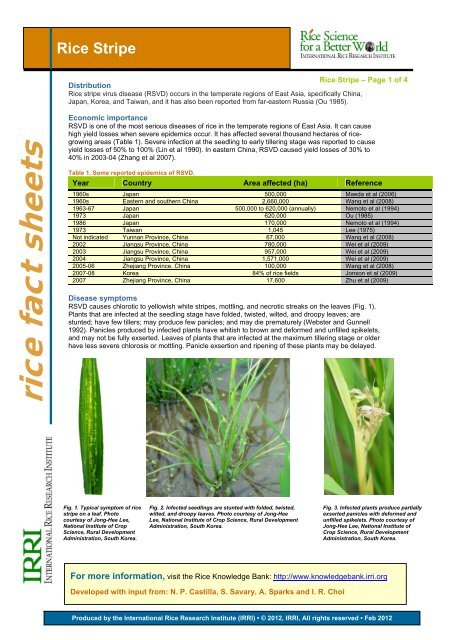

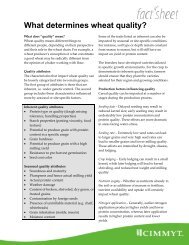


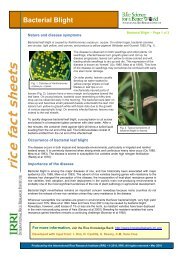

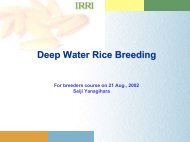
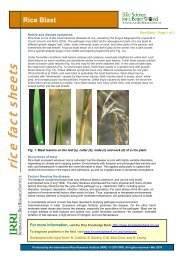
![International Standards' Organization â Rice Specification [ISO 7301]](https://img.yumpu.com/36696862/1/190x245/international-standards-organization-a-rice-specification-iso-7301.jpg?quality=85)

